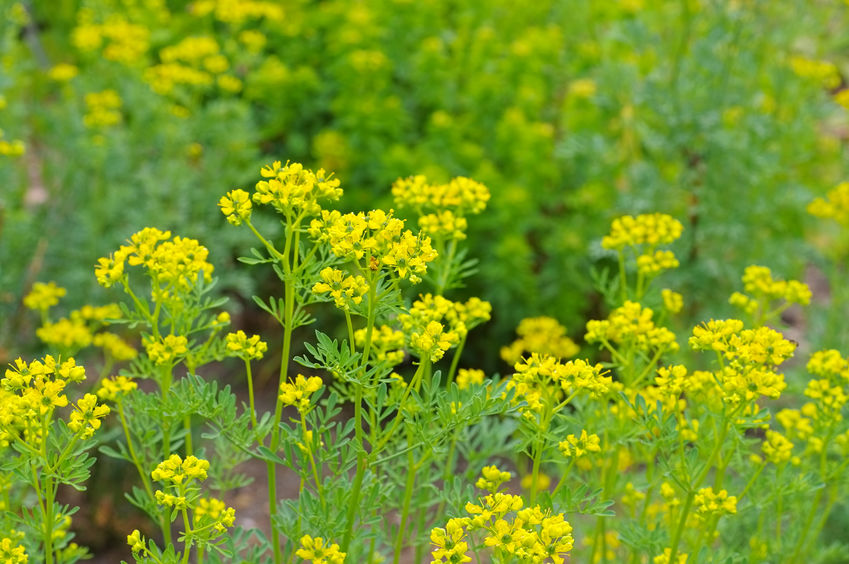Common Rue - Ruta graveolens

Common Names: Rue, Common Rue, Garden Rue, German Rue, Herb of Grace, Herb-of-Grace, Herb Grass, Rue Fétide, Rue des Jardins, Raute, Ruda, Ruta, Ruta graveolens, Ruta grav, Herbe à la Belle-Fille de Grâce, Herbe à la Belle-Fille de la Rue, Herbygrass, Sudapa
Latin Name: Ruta graveolens
Origin: Asia, Europe
Short Introduction
The usable part is the flowering tops, which are harvested on sunny mornings, twice per year, in June and autumn. Stems are cut near the woody part. The herb should be dried slowly in a draft and stored in a dry, dark place.
In Central Europe, Rue can be cultivated from seed. Common Rue thrives in warm spots, prefers light, well-drained soils with sufficient calcium, and is frost-hardy.
Detailed Description
A traditional herb used for vascular conditions.
Botanical Information
Common Rue is an evergreen, semi-woody, aromatic shrub that can reach heights of up to 80 cm. Its leaves are fleshy, dotted, bluish-green, elongated, and can be up to 15 cm long. The flowers of Rue are yellow and grow to about 12 mm in size. Common Rue blooms from March to September. The fruit is a small, brown capsule.
Origin and Distribution
Common Rue is native to Southern Europe, specifically the Balkan Peninsula. In the Czech Republic, Common Rue can be found in gardens, rockeries, fields, and meadows.
Usage / Dosage
Since ancient times, herbalist Pedanius Dioscorides described the use of Rue combined with oleander as an antidote for snake bites. The Roman historian Pliny noted Rue as an effective stimulant for inducing miscarriage. In the medieval health text Tacuinum Sanitatis, Rue is mentioned as an herb that improves eyesight and relieves bloating. Rue is a popular garden plant, known for its tolerance to heat and varying soil conditions.
Though Rue can be used for culinary purposes, its bitter taste means it is rarely consumed as food today. Historically, Rue was used more often in cooking than it is now, and it is not commonly found in vegetable markets. In Ethiopia, Rue is featured most prominently in the spice blend berbere and is sometimes briefly dipped in coffee before drinking.
In Croatia and northern Italy, Rue is used to make distinctively flavored spirits such as grappa and raki, and was once used to brew various beers. In India, Common Rue is planted around gardens and homes to repel snakes, and it also reportedly deters cats in a similar way.
Traditional Folk Medicine
Folk medicine uses Common Rue for vascular diseases (as it strengthens vessel walls and dilates blood vessels), has anti-sclerotic effects (used for atherosclerosis), prevents bleeding, and is recommended for vein inflammation, as a preventive for cerebrovascular disorders, and in cases of high blood pressure.
Other traditional healers use Rue regularly and in proper dosage to address certain digestive tract symptoms including gallbladder issues, indigestion, and painful digestive spasms.
Limitations and Contraindications
Common Rue is mutagenic and hepatotoxic, and in large amounts, can be highly toxic (with some fatal poisonings reported). It must not be used during pregnancy.
Active Compounds
Rue contains furanoacridones and two acridone alkaloids (arborinine and evoxanthine), coumarins (umbelliferone, scopoletin, psoralen, xanthotoxin, isopimpinellin, rutamarin, and rutacultin), essential oils, furanocoumarins (including chalepensin), alkaloids (skimmianine, kokusaginine, edulinine), rutin, undecan-2-one, nonan-2-one, and limonoids.
Traditional Dosage
The usable part is the dried flowering tops or just the leaves, harvested from May to June, which can be prepared as tea, macerate, or tincture. The dosage is 1 to 3 times daily – a knife tip of powder or 5 grams of dried herb to half a liter of water (the macerate should be divided into 3 doses).
Tincture is taken at 20–30 drops, 2–3 times daily. Rue is always recommended to be used in combination with Ginkgo, Horse Chestnut, Hawthorn, Wormwood, Eyebright, or Tormentil.
